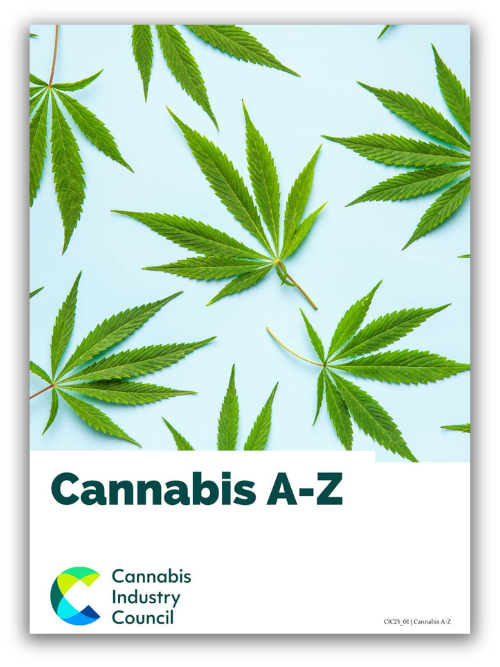Trusted guidance and resources
Cannabis: A-Z
As the cannabis industry continues to grow and evolve, it’s becoming increasingly important for both consumers and industry professionals to have a solid understanding of the terminology used within this space.
To help bridge this knowledge gap, the Cannabis Industry Council’s Standards Working Group has developed an extensive A-Z of Cannabis. With over 100 terms and definitions, this resource is a valuable tool for anyone looking to learn more about the cannabis plant, its effects, and its various applications.
By making this A-Z available to the public, we hope to contribute to a more informed and educated discussion about cannabis, its benefits, and its potential risks. To ensure accuracy and thoroughness, the Standards Working Group has consulted a wide range of sources, and a list of references can be found at the end of the page.
Aa
Describes the way in which a drug is taken or used, includes for example inhalation (vaporisation), ingestion or taking orally, and the injecting of a drug substance.
Bb
Documents that record batch production and prove batches were made according to the established work instructions and checked by quality assurance personnel. Batch records ensure uniformity in the end product and are used in product recalls as part of the quality management system.
Relating to the cheek: “the buccal side of the molars”.
Relating to the mouth: “the buccal cavity”.
Any product which has completed all processing stages up to, but not Including, final packaging.
Cc
Naturally occurring or synthetic chemicals that act on the cannabinoid receptors of mammals and some insects.
Any substance or mixture of substances intended to be used in the manufacture of a medicine and that, when used in the production of a medicine, becomes an active ingredient of that medicine. These substances are intended to furnish pharmacological activity or other direct effect in the diagnosis, cure, mitigation, treatment, or prevention of disease or to affect the structure and function of the body.
(a) cannabis; or
(b) cannabis resin; or
(c) extracts of cannabis; or
(d) tinctures of cannabis; or
(e) another drug that includes, or is from, any part of the cannabis plant
The whole dried flower (inflorescence) of the cannabis plant (Latin: Cannabis sativae flos siccus).
Corrective Action Preventive Action – a procedure in the QMS to manage significant batch deviations.
Cannabinol, a crustalline, mildly psychoactive phytocannabinoid found in very small quantities in cannabis.
Cannabinoid Based Products for Medicinal Use (CBPM) is the term used to describe unlicensed cannabinoid medicines prescribed for use in humans, under MHRA specials legislation and the 2018 amendment to the Misuse of Drugs Regulations 2001.
Dd
Ee
Ff
Gg
Hh
Ii
Administered by way of the nasal structures.
Ll
Premises at which activities authorised under a Licence take place.
Learning Management System used for training purposes – often digital.
Mm
All processes, other than production, by which drugs may be obtained and includes refining as well as the transformation of drugs into other drugs.
Abbreviation of Medicinal or Medical Cannabis.
Medical cannabis (and cannabis oils) “Medical cannabis” is a broad term for any sort of cannabis-based medicine used to relieve symptoms. Many cannabis-based products are available to buy online, but their quality and content is not known. They may be illegal in the UK, as opposed to CBPMs (a subset) that require a script from a specialist physician and whose possession under prescription is legal.
Nn
Pp
Quality Management System – A set of policies, processes and procedures required for planning and execution (production/development/service) in the core business area of an organisation.
Rr
Ss
Standard Operating Procedures.
A category of unlicensed medicines that are manufactured or procured specifically to meet the special clinical needs of an individual patient.
Sponsors are the nominated entity (Physician, prescribing nurse, company, research institute etc.) on documentation for the importation of products into the UK for use in UK clinical trials; import investigational medicinal products (IMPs) into Great Britain from outside the UK; or for prescription as a ‘special’.
A substance made by chemical synthesis to imitate its plant-derived equivalent.
Tt
Vv
verb: vape; third person present: vapes; past tense: vaped; past participle: vaped; gerund or present participle: vaping
inhale and exhale vapour containing nicotine and flavouring produced by a device designed for this purpose.
“I’d rather people vaped indoors than smoked outside”
noun: vape; plural noun: vapes
a device used for inhaling vapour containing nicotine and flavouring.
“I’ve been using a vape now for 15 weeks”
Ww
World Health Organisation is an arm of the United Nations tasked with the oversight of global health standards and disease mitigation.
Contributors
With thanks to the following contributors:
- Members of the CIC Standards Working Group
- Elisabetta Faenza, James Hutton Ltd
- Professor Mike Barnes, Cannabis Industry Council
- Ralph MacMurray, MedBud
References
- https://www.gov.uk/government/publications/guidance-on-analytical-limits-for-controlled-cannabinoids
- https://www.gov.uk/government/publications/cannabis-based-products-for-medicinal-use-in-humans-cbpms
- https://www.gov.uk/government/publications/information-about-controlled-drugs-regulations
- https://mhrainspectorate.blog.gov.uk/category/good-manufacturing-practice/
- https://mcia.org.au/mcia-code/
- https://www.unodc.org/
- https://www.incb.org/incb/en/narcotic-drugs/1961_Convention.html
- https://www.tga.gov.au/search?keywords=Cannabinoids&submit=Search
- https://www.food.gov.uk/business-guidance/regulated-products/novel-foods-guidance
- https://eiha.org/
- https://www.efsa.europa.eu/en/topics/topic/novel-food
- https://www.emcdda.europa.eu/publications/topic-overviews/cannabis-policy/html_en
- https://bedrocan.com/bedrocan-develops-new-practice-for-cannabis-cultivation/
- www.food.gov.uk/business-guidance/regulated-products/novel-foods-guidance
- www.food.gov.uk/business-guidance/cbd-products-linked-to-novel-food-applications

